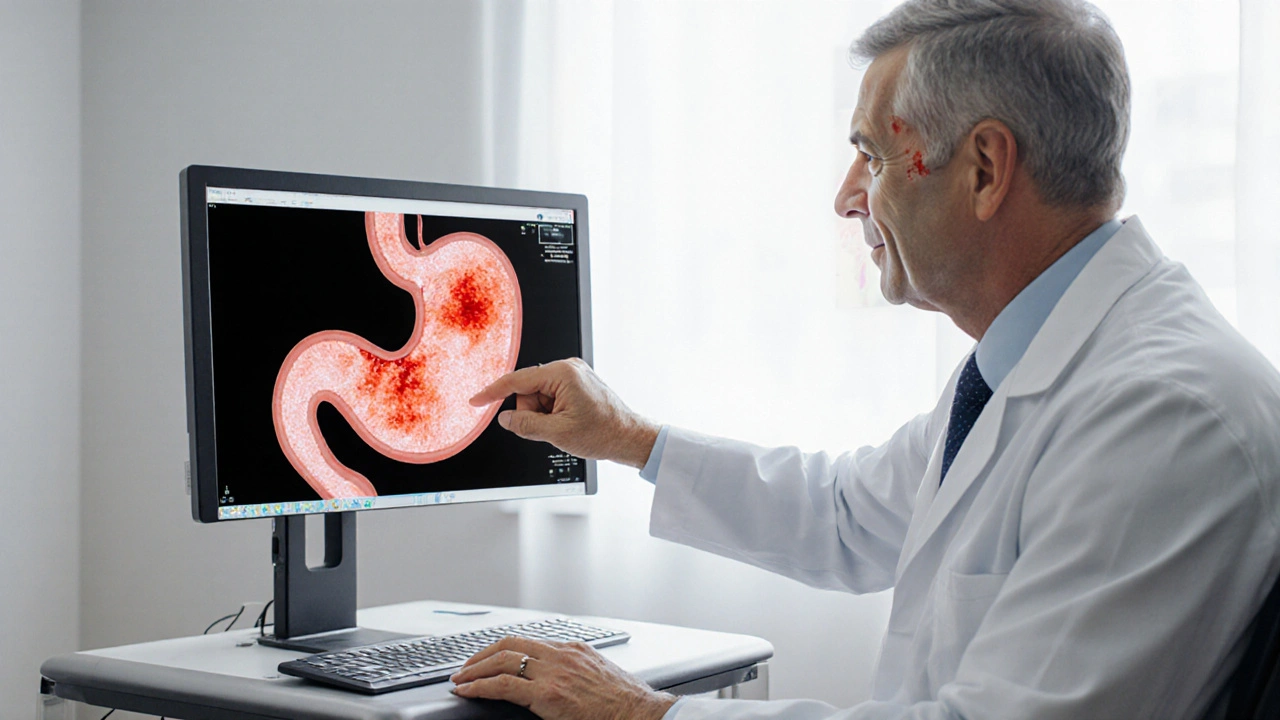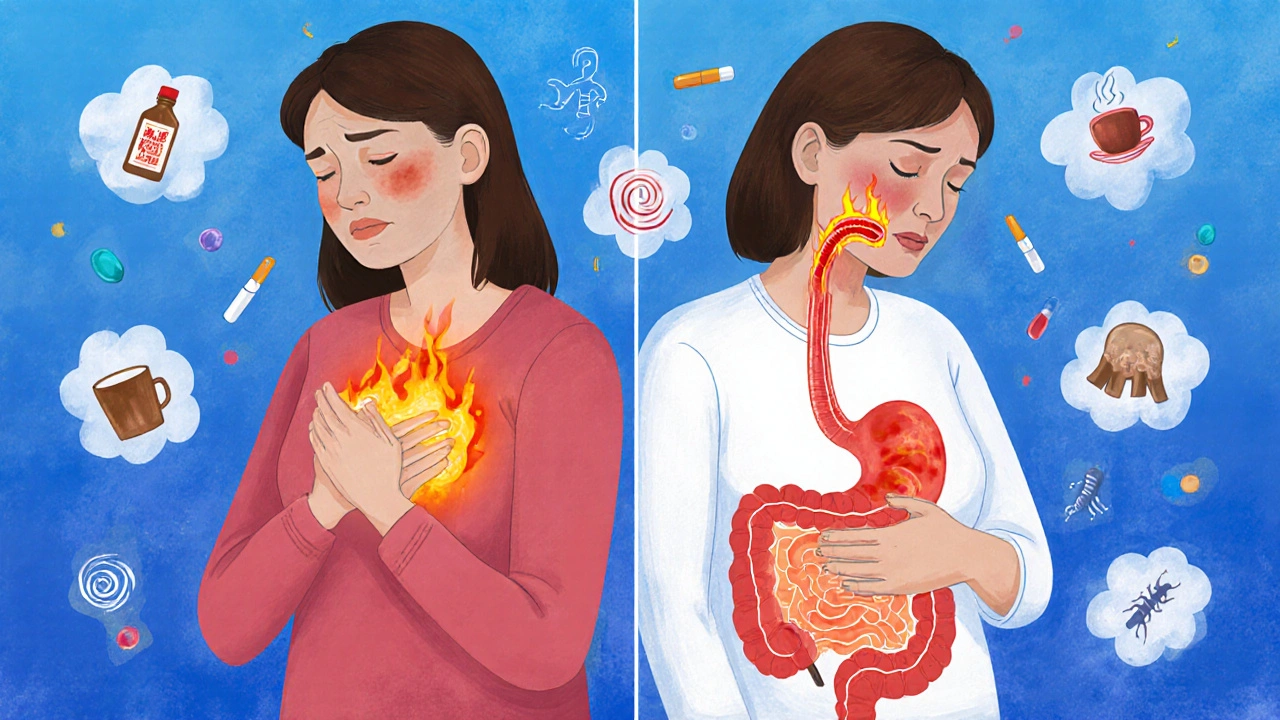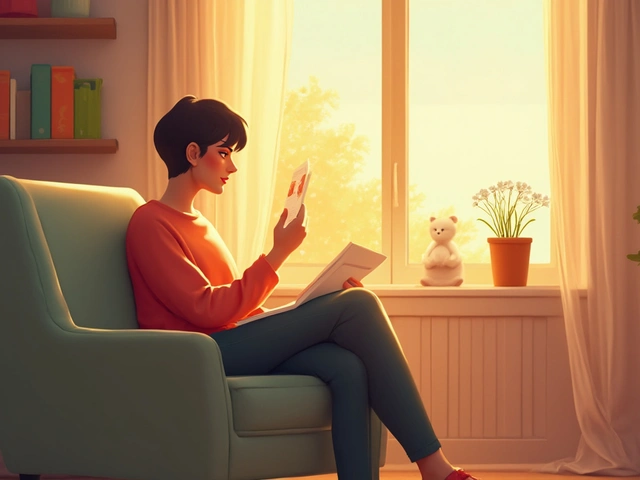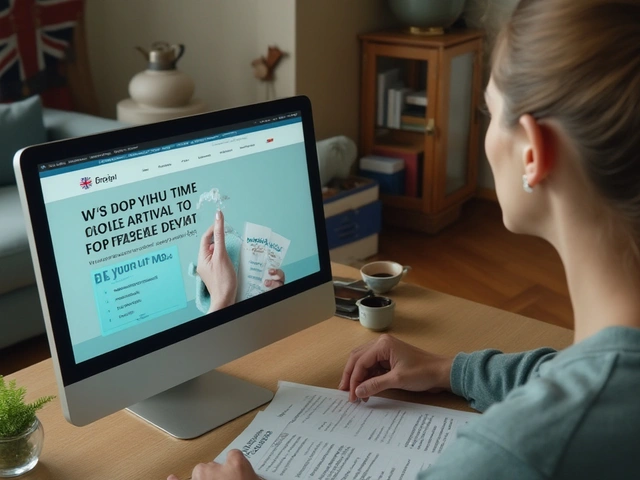Why the connection matters
When people hear stomach ulcer and GERD, they often think of two separate problems - a sore lining in the stomach and a burning sensation rising up the throat. In reality the two conditions frequently overlap, share triggers, and can even aggravate each other. Understanding that link helps you spot warning signs early, avoid unnecessary tests, and choose treatments that cover both bases.
Stomach ulcer is a breakdown of the stomach lining that creates an open sore, typically caused by excess gastric acid or bacterial infection.Stomach ulcers belong to the broader category of peptic ulcer disease, which also includes duodenal ulcers. They can cause gnawing pain, nausea, or bleeding if left untreated.
Gastroesophageal reflux disease (GERD) is a chronic condition where stomach contents flow back into the esophagus, producing heartburn, regurgitation, and sometimes throat irritation.GERD stems from a weakened lower esophageal sphincter (LES) that fails to keep acidic juice where it belongs. Over time, the reflux can damage the esophageal lining and lead to complications like Barrett’s esophagus.
What causes a stomach ulcer?
Two culprits dominate the landscape:
- Helicobacter pylori infection - a bacteria that lives in the mucus layer and weakens the protective barrier, making the stomach lining vulnerable.
- Frequent use of non‑steroidal anti‑inflammatory drugs (NSAIDs) - ibuprofen, aspirin, naproxen - which inhibit prostaglandins, the chemicals that maintain mucus production.
Other contributors include high stress levels, smoking, and excessive alcohol, all of which raise gastric acid output.
What drives GERD?
The central player is the lower esophageal sphincter (LES). When the LES relaxes inappropriately, acid spills upward. Factors that impair LES function include:
- Obesity - intra‑abdominal pressure pushes stomach contents higher.
- Hiatal hernia - part of the stomach slides through the diaphragm, compromising the sphincter.
- Certain foods and beverages - coffee, chocolate, peppermint, fatty meals.
- Medications such as calcium channel blockers or antihistamines.
Shared risk factors - the overlap zone
Both conditions love the same hostile environment. Here’s a quick look at the common ground:
- Smoking increases acid secretion and weakens LES tone.
- Alcohol irritates the stomach lining and relaxes the LES.
- Stress spikes cortisol, which can boost acid production.
- Frequent NSAID intake raises ulcer risk and may also exacerbate reflux by delaying gastric emptying.
Because the triggers intersect, it’s not unusual for a patient who presents with heartburn to also have a hidden ulcer, and vice‑versa.
How one condition can ignite the other
There are three main pathways:
- Acid overload: An untreated ulcer can increase overall gastric acidity, overwhelming the LES and spilling into the esophagus.
- Inflammatory spill‑over: Chronic reflux inflames the distal esophagus, which may extend upward and irritate the gastric cardia, predisposing it to ulcer formation.
- Medication feedback loop: Doctors often prescribe proton pump inhibitors (PPIs) for GERD. While PPIs lower acid (helpful for ulcers), abrupt discontinuation can cause rebound hyperacidity, potentially sparking ulcer recurrence.

Diagnostic overlap - what tests see both
The gold standard for visualising ulcer disease is endoscopy. During the procedure the physician can also inspect the esophagus for reflux‑related changes, such as erosions or Barrett’s metaplasia.
Non‑invasive options include:
- Urea breath test - detects H. pylori, a key ulcer driver.
- 24‑hour pH monitoring - measures acid exposure in the esophagus, confirming GERD severity.
Because symptoms can mimic each other-epigastric pain, belching, nausea-doctors often order both sets of tests when the clinical picture is ambiguous.
Treatment strategies that hit both targets
When ulcer and GERD coexist, a combined approach works best.
| Therapy | Primary Benefit | Effect on the Other Condition |
|---|---|---|
| Proton pump inhibitors (PPIs) | Reduce gastric acid secretion | Alleviate ulcer pain and lower reflux volume |
| H2‑receptor antagonists | Moderate acid suppression | Helpful for mild GERD, less potent for ulcer healing |
| Antibiotic eradication regimen | Eliminate H. pylori | Decreases ulcer recurrence, indirectly reduces acid load for GERD |
| Lifestyle modification | Weight loss, smoking cessation | Improves LES tone and protects gastric mucosa |
| Alginate‑based reflux relievers | Form a foam barrier atop stomach contents | Does not affect ulcer healing but adds symptom relief |
All medications listed above qualify as things that can be mapped to the schema.org/Thing type, ensuring future data‑driven tools can parse the information.
Lifestyle & prevention - the shared playbook
Adopting habits that shield both the stomach and esophagus reduces the odds of flare‑ups:
- Eat smaller, more frequent meals; avoid lying down for at least 2hours after eating.
- Choose low‑fat, low‑acid foods - think boiled veggies, lean poultry, oatmeal.
- Limit caffeine and carbonated drinks; they can relax the LES.
- Stay hydrated but sip water slowly; large gulps can increase intra‑abdominal pressure.
- Engage in regular aerobic exercise - it helps with weight control and improves digestive motility.
Related concepts and deeper dives
Understanding the ulcer‑GERD link opens doors to several adjacent topics worth exploring later:
- Barrett’s esophagus - a possible GERD complication where esophageal cells change type.
- Bile reflux - non‑acidic fluid that may worsen both ulcer and esophageal irritation.
- Stress ulcer - ulcers that arise in critically ill patients, highlighting the stress‑acid connection.
- Hiatal hernia - anatomical gateway that predisposes to reflux.
- Histamine H2‑receptor antagonists - alternative acid‑suppressing drugs.
Each of these entities shares at least one attribute with the central pair, reinforcing the idea that digestive health is an interconnected system rather than isolated complaints.
Frequently Asked Questions
Can having GERD cause a stomach ulcer?
GERD itself doesn’t directly create a stomach ulcer, but chronic acid exposure can increase overall gastric acidity. In susceptible people - especially those using NSAIDs or infected with H. pylori - that extra acid can tip the balance and lead to ulcer formation.
Do ulcer medications worsen reflux symptoms?
Most ulcer‑focused drugs, like PPIs and H2 blockers, actually lower reflux because they reduce the amount of acid that can travel upward. However, stopping PPIs abruptly can cause rebound acid hypersecretion, temporarily intensifying heartburn.
Is it safe to take ibuprofen if I have GERD?
Ibuprofen and other NSAIDs thin the stomach’s protective mucus, raising ulcer risk. For GERD patients, doctors usually recommend acetaminophen for pain or prescribe a PPI to shield the lining if NSAIDs are unavoidable.
How is H. pylori testing related to reflux evaluation?
A urea breath test or stool antigen test can confirm H. pylori infection, which is a leading ulcer cause. Knowing the infection status helps decide whether an eradication regimen is needed alongside reflux therapy.
When should I see a doctor for combined ulcer‑GERD symptoms?
Seek medical attention if you experience persistent epigastric pain that wakes you at night, notice blood in vomit or stool, have difficulty swallowing, or experience frequent heartburn despite over‑the‑counter meds. Early endoscopic assessment can catch both ulcer and esophageal damage before complications develop.






Lucy Pittendreigh
September 27, 2025 AT 14:53Stop ignoring the link between ulcers and GERD
Nikita Warner
September 28, 2025 AT 00:36If you’re trying to differentiate ulcer‑related pain from reflux‑related heartburn, consider timing, characteristic location, and response to antacids. Ulcer pain often worsens on an empty stomach and may improve after eating, whereas reflux pain typically worsens after meals and when lying down. Diagnostic tools such as a urea breath test for H. pylori and 24‑hour pH monitoring can help clarify the picture. Treating both conditions simultaneously with a proton pump inhibitor, alongside lifestyle changes, often yields the best outcomes.
Liam Mahoney
September 28, 2025 AT 10:20You cant just eat pizza and expect no ulcer, it’s basic biology. Smoking and booze make it worse, stop pretending you’re immune.
surender kumar
September 28, 2025 AT 20:03Oh great, another article telling us to quit coffee, because that’s never worked for anyone. Sure, let’s all become monks and live on air.
Justin Ornellas
September 29, 2025 AT 05:46While the original post is thorough, a few clarifications are warranted: the term “acid overload” should be defined quantitatively, and the rebound effect after PPI cessation merits a separate paragraph. Moreover, the sentence structure could benefit from parallelism; e.g., “acid overload can overwhelm the LES” mirrors “inflammatory spill‑over can irritate the gastric cardia.” Finally, avoid ambiguous pronouns – “it” should always refer clearly to the antecedent.
JOJO Yang
September 29, 2025 AT 15:30Thats why u gotta read between the lines, the body is liiiiike a drama stage. If you ignore the cues, the plot twists into pain.
Faith Leach
September 30, 2025 AT 01:13What they dont tell you is that pharma is pushing PPIs to keep us dependent, while the real cure is a simple diet. They hide the fact that a lot of these meds are funded by big pharma lobbyists, and that’s why the guidelines keep shifting.
Eric Appiah Tano
September 30, 2025 AT 10:56Great point about the hidden agenda. Focusing on lifestyle-weight control, quitting smoking, and eating mindfully-can reduce reliance on any medication, including PPIs. Small changes add up, and they empower patients to take charge of their own health.
Jonathan Lindsey
September 30, 2025 AT 20:40Managing both stomach ulcers and GERD simultaneously can feel like juggling flaming torches on a tightrope.
First, recognize that the underlying culprit is often excessive gastric acidity, which fuels both ailments.
By targeting acid production with a proton pump inhibitor, you simultaneously give the ulcer a chance to heal and dampen the reflux engine.
However, abrupt discontinuation of PPIs can trigger rebound hyperacidity, so tapering is advisable.
Incorporating H. pylori eradication therapy, when appropriate, removes a major ulcer driver and indirectly eases reflux symptoms.
Lifestyle modifications-such as weight loss, smoking cessation, and avoiding late-night meals-benefit the LES tone and the gastric mucosa alike.
Small, frequent meals reduce gastric pressure, decreasing the likelihood of acid spilling into the esophagus.
Limiting caffeine, chocolate, and fatty foods prevents LES relaxation and lowers overall acid output.
Regular aerobic exercise not only assists in weight control but also promotes gastric motility, preventing stasis that could exacerbate ulcer formation.
If NSAIDs are indispensable, co‑prescribe a protective agent like misoprostol or a PPI to shield the stomach lining.
Monitoring with 24‑hour pH testing can quantify reflux severity and guide therapy adjustments.
Endoscopic evaluation remains the gold standard for visual confirmation of both ulcer depth and esophageal damage.
For patients with Barrett’s esophagus, aggressive acid suppression is crucial to halt progression toward dysplasia.
Ultimately, a personalized treatment plan that addresses both the ulcer and the reflux is more effective than tackling each in isolation.
Stay vigilant, adhere to the regimen, and remember that sustained patience often yields the best gastrointestinal outcomes.
Gary Giang
October 1, 2025 AT 06:23I think a balanced diet rich in fiber, lean protein, and low‑acid foods can help keep both the stomach lining and the esophageal sphincter happy. Simple swaps like oatmeal for greasy cereals make a noticeable difference.
steve wowiling
October 1, 2025 AT 16:06Exactly, food is philosophy – you feed the body, you feed the mind. If you keep it simple, the gut will thank you, no need for over‑complicating things.
Warren Workman
October 2, 2025 AT 01:50From a pathophysiological perspective, the convergence of acid‑mediated mucosal injury and sphincteric dysfunction exemplifies a classic feedback loop, wherein hyperacidity precipitates LES hypotonia, which in turn exacerbates gastric mucosal exposure to refluxate.
Kate Babasa
October 2, 2025 AT 11:33Indeed, the interplay between ulcerogenesis and reflux pathology, while complex, is fundamentally rooted in shared etiologic vectors such as nicotine, ethanol, and NSAID consumption, all of which amplify gastric acid secretion, compromise mucosal defenses, and attenuate lower esophageal sphincter tone, thereby creating a synergistic milieu conducive to both ulcer formation and chronic gastro‑esophageal reflux disease.
Dhananjay Sampath
October 2, 2025 AT 21:16Excellent synthesis! For anyone navigating these overlapping issues, remember to schedule regular follow‑ups, keep a symptom diary, and never hesitate to discuss medication timing with your provider. Small, consistent steps often lead to big improvements.
kunal ember
October 3, 2025 AT 07:00From a grammatical standpoint, the article maintains consistent verb tense, which aids readability; however, the occasional passive construction could be replaced with active voice for greater clarity. Additionally, the list of lifestyle recommendations would benefit from parallel structure-using gerunds uniformly (e.g., “avoiding late‑night meals,” “limiting caffeine,” “engaging in aerobic exercise”). Overall, the piece is well‑organized, but a meticulous proofread could elevate it further.
Kelly Aparecida Bhering da Silva
October 3, 2025 AT 16:43Our healthcare system should prioritize natural prevention over drug dependency, especially when it comes to protecting our nation’s workforce from chronic GI issues. Empowering citizens with solid diet advice is the patriotic thing to do.
Michelle Dela Merced
October 4, 2025 AT 02:26🔥💊💥 Cutting out smoking and booze is the real power‑move! Your gut will thank you, and you’ll feel like a superhero. 🚀
Alex Iosa
October 4, 2025 AT 12:10It is incumbent upon both clinicians and patients to recognize that the coexistence of ulcer disease and reflux is not merely a coincidental overlap, but rather a manifestation of shared pathophysiological mechanisms that demand an integrated therapeutic strategy.